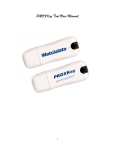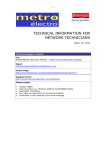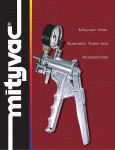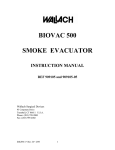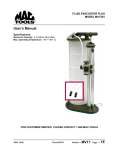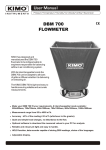Download Evacuator Synergy RF Instructions
Transcript
Evacuator Synergy RF Instructions Evacuator Synergy RF Alert System Specification and user operating instructions. Thank you for choosing the Evacuator Synergy RF Wireless Alert system. In order for you to realise the full potential and reliability of this Category One Wireless system it is vitally important that you read this user manual in full before attempting to use the system. Failure to understand the correct installation method and functions of the system may lead to intermittent and unreliable connectivity. We would be delighted to assist all Evacuator Alarm clients with free Telephone Support during office normal hours. For assistance please contact our Technical Support Team on 0845 130 7258 or alternatively email us on [email protected]. Specification Overview (All models) Cable and wire free operation. 40 Call Points per Zone. Unlimited number of Sounder strobe units (subject to system design criteria) 16 Secure Zones. No laptops or Tablets required. Licence free Radio Operation. Low battery indication. Secure Swipe Test and Reset Fob. Category 1 Receiver Setting up your Synergy Wireless System 1. Each unit comprises of a front and back plate. These two halves must be separated in order to connect the battery to the PCB, and to mount your unit to a wall or post. 2. You will need to remove the single, M4 Phillips head (POZI) screw in the BOTTOM hole of the Red front mounted flasher/sounder. TIP: Pushing down with very light pressure onto the screwdriver as you are removing the screw will help you to separate both halves of the unit. 3. Now that both halves have been separated you can Drill out the four 6mm holes through the back plate (Drill points are indicated by moulded “pips on the back plate) Now mount the back plate to the wall or post using a suitable 6mm shank screw or bolt along with a 6mm ID/12mm OD flat washer between the screw head and the plastic moulding (These four washers are important and should not be omitted otherwise the screws or bolts could split the plastic back plate moulding). 4. NOTE: Before fixing into place be sure that the “TOP” on the reverse of the back plate is noted along with the orientation of the back plate. ONCE THE BACK PLATE IS MOUNTED TO THE WALL/POST DO NOT FIX THE FRONT COVER TO THE BACK PLATE UNTIL THE THREE DIALS ON THE PCB HAVE BEEN SET. Device Numbering IMPORTANT: Each device must have its own unique address. Failure to observe this will result in system failure. You can address up to mixed 40 Call points, Automatic Smoke Detectors or Base Stations (0 – 39) per Zone. Device 1-39 will be described as “Slaves” in this instruction manual. 0 Described as "Master". It is also possible to expand your system with an www.evacuatoralarms.com unlimited number of Sounder /Strobe units subject to System design criteria. These units will be described as “Drones “in this instruction manual. Master Unit (00) Each system must have its Master unit set first, this is done by setting Dial 2 to 0 and Dial 3 to 0. Your system can only have one Master Unit. To get maximum performance from your system you are best locate your master unit at the centre of the site. The master can either be a Call Point, Auto Detector or Base Station. Slave Units (1-39) Slave units can be either a Call Point, Sounder/Strobe, Auto Detector or Base Station. When numbering these devices we recommend numbering them in numerical order for testing. Drones (40) Only the Sounder/Strobe unit can be set as a drone unit. This is done by setting dial 2 to 4 and dial 3 to 0 making it device 40. We recommend a maximum of 2 per Slave unit in your system i.e. 20 slaves and 40 Drones. As you can see above there are 3 dials, dial 1 on the left is NOT needed for device numbering. Dial 2 and 3 are used for your device numbering, as you can see dial 2 is set to 0 and dial 3 to number 3. This makes the device number 03. to set a device to number 20 for example dial 2 would be set to 2 and dial 3 set to 0. Note: When setting the dials, please use the setting driver supplied Zone Dial (Dial 1) This dial is factory set to "0" and will not need to be changed unless you wish to separate a number of systems that will be operating within 2km of each other. This will be used for example if there are several contractors using the system on the same site or in the same area. It may also be beneficial to separate zones for floors on larger projects. Device Dials (Dial 2 and 3) These dials are used to number the Devices as above. Dial 2 will only be used from 0-4, Dial 3 will use 0-9. www.evacuatoralarms.com Note: Each system must have one Master Device (00), to obtain maximum performance we recommend the master is in the centre of the site. In order to identify the Device numbers we recommend using the Device number box located on the side of the stickers. Fitting the Antenna The rubber duck antenna should now be fitted to the Silver BNC docking point located on the top of the front cover. The Antenna should be placed over the BNC connector and twisted in clockwise motion until it locates into place. Test that it has been located correctly by gently pulling on the Antenna in an outwards motion. Connecting the Battery and Fitting Front cover The battery should be secured onto the back plate with the industrial Velcro supplied. Also be sure that the black and red power leads are orientated to the right hand side of the moulding back plate facing up. Now connect the white (male) two way plug from the battery into the white (female) plug located on the inside of the front cover. Once connected offer the front cover upto the wall mounted back plate making sure that the battery lead does not foul on the central screw boss of the back plate. Once connected you will notice that the LED on the front panel begins to flash. When the front cover is located onto the back plate replace the M4 screw into the bottom of the Siren Flasher/Strobe hole and locate it into the threaded insert in the back plate. This can now be tightened down to pull the front cover flush to the back plate. DO NOT OVERTIGHTEN OR USE A BATTERY OPERATED DRILL/SCREWDRIVER TO TIGHTEN THE SCREW AS THIS WILL RESUKT IN PERMENANT DAMAGE TO THE FLASHER SOUNDER UNIT. Status LED LED Red & Green alternate flashing Green Flashing (30 sec interval) Blue Flashing (30 sec interval) Red Blinking Blue Solid Red Solid White Flashing Green Rapid Flashing Red Rapid Flashing Status Power Up Sequence Standby Standby Master Device (Set 00) Low Battery Test Mode Reset Mode Alarm Mode Out of Range Out of Range & Low Battery Testing the System Testing the system is easy. If you are using the system without a Base Station you will need to purchase an Evacuator Secure Key Fob. To put the system in to Test swipe the fob over the Test System Logo on the left hand side of the product on any device in the system. This will then turn the Status LED Solid Blue on all of the linked Devices. You will then have to walk the site making sure all LED's are blue. When you are happy all LED's are blue in the system you can swipe the Key Fob over www.evacuatoralarms.com the Reset System logo on the right hand side of any of the Devices. The Status LED will then go Solid Red, allow 90 seconds for the system to return into Standby mode. Note: To perform the Test without a Base Station you will require a Evacuator Secure Key Fob Full Alarm A full alarm can be raised from any Call Point in the system by lifting the hinged call point cover and pressing the Push Button. This sounds the main beacon and flashes the strobe light on all Devices connected to the system. The status LED will also Flash white. This will only stop when a reset command is in place. Resetting the System If you are using the system without a Base Station you will need to purchase an Evacuator Secure Key Fob. To put the system in to Reset swipe the fob over the Reset System Logo on the right hand side of the product on any device in the system. The Status LED will then go Solid Red, allow 1 minute for the system to return to Standy mode. Note: To perform System Reset without a Base Station you will require a Evacuator Secure Key Fob Final notes before use. The Evacuator Synergy Category one Alert System has the flexibility to be utilised in a variety environments and is suitable for a variety applications. However, It is the responsibility of the user/s to determine the application and suitability of the products/s before use. Because we have no control over the systems use, installation or application, FMC Fire, Evacuator Alarms its agents, distributors or employees accept no liability for loss or damages to property or persons that may have been incurred by the use of this product. We would therefore insist that a full risk assessment of the site and of the Synergy systems intended use is carried out before installation of the system. If you are not completely convinced or satisfied that this product will meet your safety or alert requirements then the Synergy Wireless System should not be used and must be returned to your place of purchase immediately in its original packaging. E&OE. www.evacuatoralarms.com




